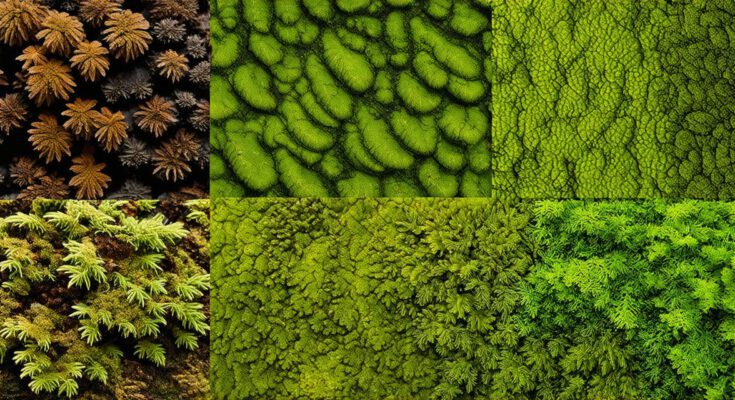Cryptogams are fascinating organisms that have captivated the scientific community and general public alike for centuries.
They are often referred to as “slime molds” or “blobs” due to their soft, gelatinous appearance and unique abilities to form complex shapes and structures. In this comprehensive guide, we will explore the characteristics of cryptogams, their ecological roles, and the ongoing research into these fascinating organisms.
What are Cryptogams?
Cryptogams are a diverse group of non-photosynthetic eukaryotes that lack specialized cells for photosynthesis. They are characterized by their soft, gelatinous bodies and the ability to form complex shapes and structures through the process of pseudopodia, which are cytoplasmic extensions of cells that allow them to move and manipulate their environment.
Characteristics of Cryptogams
One of the most striking features of cryptogams is their ability to form complex shapes and structures. They do this by utilizing pseudopodia, which are cytoplasmic extensions of cells that allow them to move and manipulate their environment. These structures can range from simple tubes to intricate networks and even entire organisms.
Cryptogams also have a unique ability to respond to environmental cues, such as light, gravity, and temperature changes. This allows them to adapt to changing conditions and maintain their overall structure and function.
Another characteristic of cryptogams is their lack of specialized cells for photosynthesis. This means that they do not require sunlight to survive, making them well-suited to environments where light is scarce or absent altogether. Instead, they obtain nutrients by consuming other organisms, either by engulfing them whole or breaking them down with enzymes.
Cryptogams also have a high degree of plasticity, meaning that they can easily change their shape and structure in response to environmental cues. This allows them to adapt to changing conditions and maintain their overall function, even in the face of adversity.
Ecological Roles of Cryptogams
Cryptogams play a wide range of ecological roles, depending on the environment they inhabit. In soil, they are often referred to as “detritivores” because they consume dead plant and animal matter, breaking it down into smaller pieces that can be used by other organisms. They also play an important role in nutrient cycling, particularly in environments where nutrients are scarce or immobile.
In leaf litter, cryptogams are often referred to as “decomposers” because they break down dead leaves and other plant matter. They also play an important role in soil formation, helping to create a stable soil structure that supports the growth of plants and other organisms.
In aquatic environments, cryptogams are often referred to as “bloomers” because they can form massive mats of cells that cover large areas of the ocean floor. These blooms can have both positive and negative effects on marine ecosystems, depending on the species of cryptogam and the environmental conditions under which they grow.
Research into Cryptogams
Cryptogams have been a subject of scientific interest for centuries, and ongoing research continues to uncover new insights into their biology and ecology. One area of particular focus is their ability to form complex shapes and structures, and how this process is influenced by environmental cues such as light, gravity, and temperature changes.
Scientists have also been studying the role of cryptogams in nutrient cycling, particularly in environments where nutrients are scarce or immobile. They have found that cryptogams can play a critical role in breaking down complex organic compounds into simpler ones that can be used by other organisms, helping to maintain a stable and productive ecosystem.
In addition, there is ongoing research into the potential uses of cryptogams in biotechnology. Some species are capable of producing biofuels or other valuable chemicals, making them a promising source of renewable energy and materials.
Case Studies of Cryptogams
One example of a cryptogam that has captured the attention of scientists and the public is the slime mold known as Dictyostelium discoideum. This species is often referred to as “the social amoeba” because it exhibits complex behaviors that are similar to those of animals, including communication, cooperation, and even the ability to form multi-cellular structures.
Real-Life Examples of Cryptogams
Cryptogams can be found in a wide range of environments, including forests, deserts, and even the depths of the ocean. One example is the slime mold known as Leucoagarum giganteum, which forms massive mats of cells on tree trunks and branches in tropical rainforests. These blooms can cover entire trees and are often referred to as “devil’s fingers” due to their eerie appearance.
Another example is the sea slime mold known as Phaeophyta, which forms massive mats of cells on the ocean floor in cold, nutrient-poor waters. These blooms can cover entire areas of the seafloor and are an important source of food for marine organisms such as fish and crustaceans.
FAQs
What are cryptogams?
Cryptogams are a diverse group of non-photosynthetic eukaryotes that lack specialized cells for photosynthesis. They are characterized by their soft, gelatinous bodies and the ability to form complex shapes and structures through the process of pseudopodia.
What ecological roles do cryptogams play?
Cryptogams play a wide range of ecological roles, depending on the environment they inhabit. In soil, they are often referred to as “detritivores” because they consume dead plant and animal matter. In leaf litter, they are often referred to as “decomposers” because they break down dead leaves and other plant matter. In aquatic environments, they are often referred to as “bloomers” because they can form massive mats of cells that cover large areas of the ocean floor.
What ongoing research is being conducted into cryptogams?
Ongoing research continues to uncover new insights into the biology and ecology of cryptogams. One area of particular focus is their ability to form complex shapes and structures, and how this process is influenced by environmental cues such as light, gravity, and temperature changes. Scientists are also studying the role of cryptogams in nutrient cycling, particularly in environments where nutrients are scarce or immobile. In addition, there is ongoing research into the potential uses of cryptogams in biotechnology.
What are some real-life examples of cryptogams?
One example of a cryptogam that has captured the attention of scientists and the public is the slime mold known as Dictyostelium discoideum, which exhibits complex behaviors that are similar to those of animals. Another example is the sea slime mold known as Aegagropila linnaei, which forms massive mats of cells on the ocean floor in aquatic environments.



